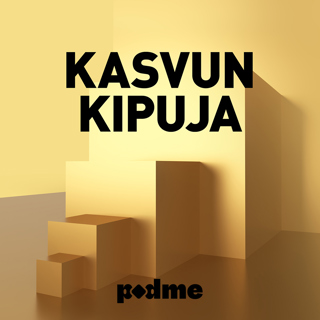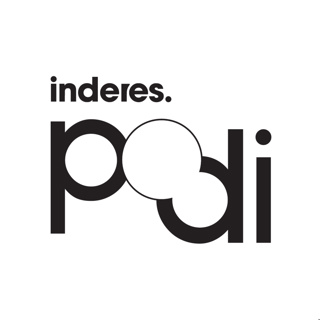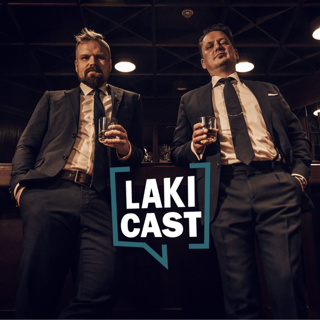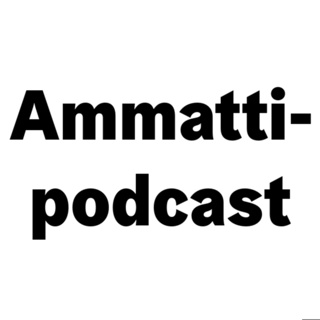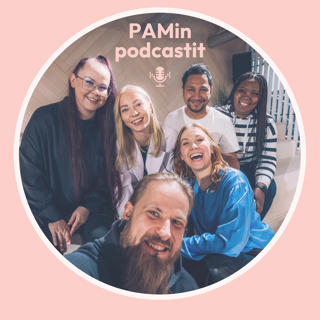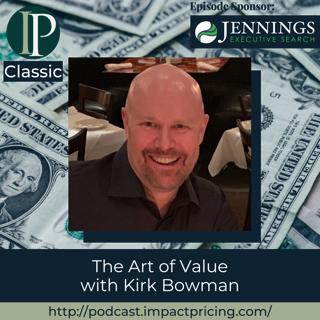
#CLASSIC The Art of Value with Kirk Bowman
Kirk Bowman is the founder and Visionary of Value and the Art of Value, a pricing consultancy in Dallas, TX. His podcast, the Art of Value Show, is one of the most shows for knowledge professionals. He has spoken at numeration conferences on pricing including QuickBooks Connect and Scaling New Heights. In 2011, he was appointed a Practicing Fellow at the VeraSage Institute, the think tank founded by Ron Baker. His software company, MightyData, was featured in the book Implementing Value Pricing. In this episode, Kirk talks about value pricing, how he was introduced to it and later switched to this method in estimating and billing customers. Be inspired as he shares how this decision increased his revenue by over 50% in the first year and 70% in the second. Learn this and more in his journey on value pricing. Why you have to check out today’s podcast: Find out how Kirk learned about the concept of value pricing Identify the two categories in measuring results Find out details about Kirk’s pricing consultancy company and his podcast “The next time the customer asks for a lower price, turn around and ask them what value they are willing to do without in order to get that price.”– Kirk Bowman Topics Covered: 01:36 – How Kirk discovered value pricing 03:40 – The concept of value pricing and how it aligns the interests of the professional with his customer 07:13 – Two categories in measuring value: results or outcomes, and how the two differ 12:11 – Sharing the profile of his pricing consultancy company – Art of Value and how it is helping professionals with their business models 14:32 – His podcast – Art of Value and the reason he loves doing it 19:37 – His pricing advice that has a significant impact Key Takeaways: “The customer’s interests are the most important thing. When you align with that, you’re lining things up for success.” – Kirk Bowman “It’s so important to put alignment upfront as one of the things that you’re striving for and keep your eye on at all times because it is in our human nature to focus on our own self-interest and so the focus on theirs, it requires intentionality. It requires strong character.” – Kirk Bowman “Value and pricing are subjective, and by the way, that’s okay.” – Kirk Bowman Connect with Kirk Bowman: LinkedIn: https://www.linkedin.com/in/kirkbowman/ Website: https://artofvalue.com/ Connect with Mark Stiving: LinkedIn: https://www.linkedin.com/in/stiving/ Email: mailto:mark@impactpricing.com
19 Joulu 202221min

Blogcast: What Selling Value Means
This is an Impact Pricing Blog published on November 9, 2022, turned into an audio podcast so you can listen on the go. Read Full Article Here: https://impactpricing.com/blog/what-selling-value-means/ If you have any feedback, definitely send it. You can reach us at mark@impactpricing.com. Now, go make an impact. Connect with Mark Stiving: Email: mark@impactpricing.com LinkedIn: https://www.linkedin.com/in/stiving/
16 Joulu 20222min
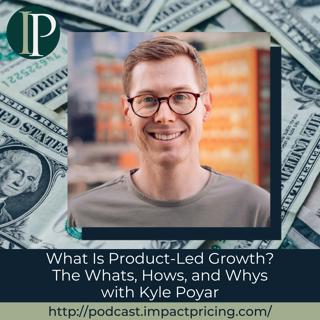
What Is Product-Led Growth? The Whats, Hows, and Whys with Kyle Poyar
Kyle Poyar is a product-led growth expert who worked for Simon-Kucher & Partners for six years where he was a consultant, senior consultant and manager, and director. Currently, he is the operating partner of OpenView, a firm that helps build software companies into market leaders by helping them hire the best talents, acquire and retrain the right customers, and partner with industry leaders so that they can dominate their markets. In this episode, Kyle talks us through the details of product-led growth and how it became popular in the recent years. He also shares some tips on how to make it work on businesses in certain industries. Why you have to check out today’s podcast: Learn the definition of Product-Led Growth Find out if Product-Led Growth model is suitable for your business Learn how to shift from Sales-led model to Product-led model “With the reverse trial, your customers land in a premium version of your product, have a time-limited period that they can access it, and then they can either convert and essentially purchase, or they can keep using a free version of the product. What ends up happening is you get the best of both worlds between freemium and free trial, and so you don't actually have to choose between the two” – Kyle Poyar Topics Covered: 01:17 – How Kyle got into pricing 03:04 – More than just about numbers pricing has qualitative aspects as well 04:12 – What is product-led growth? 06:50 – Product-led growth is more than just prioritizing product over sales and marketing people 08:17 – Most companies strategized product-led growth from scratch until it was standardized 10:04 – Can companies do freemium that is not product-led growth? 11:47 – When product-led companies bring salespeople into the process 14:49 – Salespeople in product-led companies are not prospecting 15:28 – Self-serve sales work most of the time, but some transactions require salespeople 18:40 – The types of companies that does and doesn’t work for product-led growth 22:26 – How Kyle would coach a sales-led company who wants to shift to product-led growth model 25:50 – Does it make sense for PLG companies to spend more on the expand side of “land and expand”? 27:07 – Kyle’ pricing advice 28:33 – Connect with Kyle Key Takeaways: “In my mind, why product-led growth has taken off is because end users, as opposed to just executive buyers, have more and more power in bringing software into work. And so, you can actually make your product discovered by those users, show value to those folks and enable them to become champions in your buying process” – Kyle Poyar “Freemium is a subset of PLG. If you're doing freemium by default, you're taking steps into product led growth. But freemium isn't required to be a product-led company by any means.” – Kyle Poyar “I advise companies to think in terms of where there's the most friction in their current motion and what are product-led solutions that can help solve that friction and improve upon a KPI that we want to improve on right now, and that takes us on this path to doing more PLG in the future.” – Kyle Poyar Connect with Kyle Poyar: LinkedIn: https://www.linkedin.com/in/kyle-poyar/ Connect with Mark Stiving: LinkedIn: https://www.linkedin.com/in/stiving/ Email: mailto:mark@impactpricing.com
12 Joulu 202229min

Blogcast #84: A Fabulous New Behavioral Economics Trick
This is an Impact Pricing Blog published on November 2, 2022, turned into an audio podcast so you can listen on the go. Read Full Article Here: https://impactpricing.com/blog/a-fabulous-new-behavioral-economics-trick/ If you have any feedback, definitely send it. You can reach us at mark@impactpricing.com. Now, go make an impact. Connect with Mark Stiving: Email: mark@impactpricing.com LinkedIn: https://www.linkedin.com/in/stiving/
9 Joulu 20223min
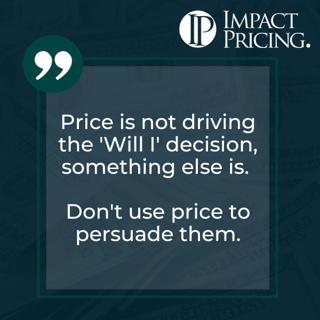
Pricing Table Topics #86: Jack of Clubs: Price Is Not Driving the 'Will I' Decision
This one is the Jack of Clubs from the Selling Value card deck. It's true, price doesn't drive the 'will I' decision. When people are making a 'will I' decision they're trying to decide, is this a place where I should spend my resources? And although you can imagine if I make a huge change in price, I could get somebody to change their mind in terms of, will they buy in this product category or not. But most of the time that's not what's driving the decision. For example, are you in the market to buy a new car today? I'm guessing the answer is no. But what if you have an accident and your car is totaled? Well, all of a sudden, you're in the market for a new car. And it isn't the price. If we lowered the price, we raised the price, that wasn't driving your decision. It was the fact that the need came up. You realized the need, and it was a really important problem. Are you in the market to buy a new refrigerator? Probably not. What if your refrigerator breaks down? Almost everything we can go through this same example where you're not in the market to go buy something, until of course something happens to prompt you to say, hey, I'd really like one of those, and then you can go shopping for which one you want to go buy. But in the beginning, it's not the price. And so small changes in price really don't change anybody's mind in terms of, am I going to go buy something in this product category? We hope you enjoyed this example of Pricing Table Topics. If you want to get better at speaking, especially about pricing and value, grab a deck of our cards, pull a random card and read the saying, then talk for one to two minutes about what the card says. If you have any questions or feedback, please email me, mark@impactpricing.com. Now, go make an impact. Connect with Mark Stiving: Email: mark@impactpricing.com LinkedIn: https://www.linkedin.com/in/stiving/
7 Joulu 20222min
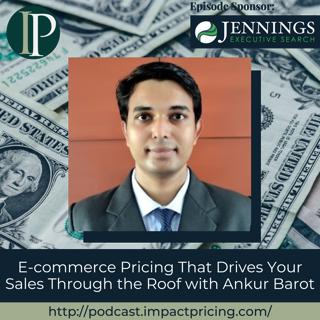
E-commerce Pricing That Drives Your Sales Through the Roof with Ankur Barot
Ankur Barot started his career in engineering and soon transitioned to business. Currently, he is an e-commerce expert and is working as the manager of strategic initiatives at BigBasket, one of the biggest online grocery platforms in India. In this episode, Ankur talks to us about the important strategies when it comes to pricing in the world of e-commerce. He shares valuable tips on how to make customers choose your platform over your competitors’, and how to charge different prices on different customers depending on their buying behavior and your competitors’ prices. Why you have to check out today’s podcast: Find out the factors to consider in pricing your products in the online market Learn how to make customers choose your platform over your competitors’ platforms Discover how to charge different prices on different customers by monitoring their buying behavior and your competitors’ prices “In pricing, it is definitely very important considering how your costs are aligned and how the competitive prices align. A large part is also on how you are communicating the price to customers.” – Ankur Barot Topics Covered: 01:32 – How Ankur got into pricing 02:17 – The work that BigBasket does, and what makes it unique 04:29 – COVID gave the companies that did delivery a chance to explode in growth 05:54 – Ability to shop in stores again did not stop customers from ordering online 06:39 – COVID was almost like a forced trial where people had to order online; and they found it to be easier and more convenient 08:11 – Promotions and other factors that determine whether customers will place an order on your platform or not 11:21 – How to get customers to order on your platform instead of your competitor’s platform 16:12 – Analyze how much your customers are willing to pay for a product; Make sure the customers would get what they want even right before the billing process 20:05 – How to charge different prices to different customers by monitoring their buying behavior as well as the competitors’ prices 23:29 – How companies in India find the prices of their competitors’ products 27:02 – Ankur’s pricing advice 29:36 – Connect with Ankur Key Takeaways: “We learned that pricing plus the stock availability as well as assortment, as well as how you are charging the convenience fee – all these aspects will decide whether the customer is placing an order on your platform or not.” – Ankur Barot “It is not about only the product pricing that the e-commerce portal has, it is what other parts of the chain that will bring in a customer and place an order on your platform.” – Ankur Barot “At the back end, what the company or what we are trying to do is select our key value items that the customer will remember the prices for, and we’ll definitely build a long-term perspective that they are the cheapest among all the competitors.” – Ankur Barot People / Resources Mentioned: BigBasket: https://www.bigbasket.com/ Connect with Ankur Barot: LinkedIn: https://www.linkedin.com/in/ankurbarot/ Email: ankurbarot19@gmail.com Connect with Mark Stiving: LinkedIn: https://www.linkedin.com/in/stiving/ Email: mailto:mark@impactpricing.com
5 Joulu 202230min

Blogcast #83: More Lessons from Netflix
This is an Impact Pricing Blog published on October 26, 2022, turned into an audio podcast so you can listen on the go. Read Full Article Here: https://impactpricing.com/blog/more-lessons-from-netflix/ If you have any feedback, definitely send it. You can reach us at mark@impactpricing.com. Now, go make an impact. Connect with Mark Stiving: Email: mark@impactpricing.com LinkedIn: https://www.linkedin.com/in/stiving/
2 Joulu 20222min
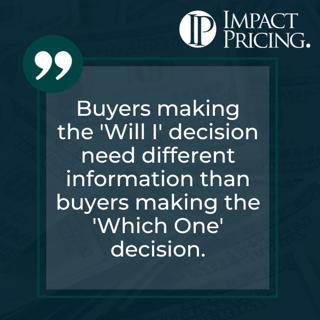
Pricing Table Topics #85: Jack of Hearts: 'Will I' Decision Needs Different Information than 'Which One’ Decision
This is the Jack of Hearts from the Selling Value card deck. It's true, buyers making the 'will I' decision do need different information than those making the 'which one' decision. In the 'will I' decision, they're trying to decide, should I buy something in this product category or not? What they're really saying is, is this a place I should spend my budget? Or you could think of this as, how big is the problem I'm going to solve, should I spend these resources to go solve this problem? And that's the information they want to know is, what's the value of solving this problem? Once they've said, yes, that seems like a good place to spend my money. Then they move on to making a 'which one' decision. Should I buy your product or should I buy a competitor's product? When they're making this 'which one' decision, they're now looking at the differences of the products, the features, and in fact, they're trying to estimate how much value is that feature for that one more expensive product. I often like to think what they're really asking is, is the more expensive product worth it? So, when buyers are making the 'which one' decision, they're actually looking at the differentiation of our products. So, it's true, buyers making the 'will I' decision do need different information than buyers making the 'which one' decision. We hope you enjoyed this example of Pricing Table Topics. If you want to get better at speaking, specifically about pricing and value, grab a deck of our cards, pull a random card, read the saying, and then talk for one to two minutes about what that card says. If you have any questions or feedback, please email me, mark@impactpricing.com. Now, go make an impact. Connect with Mark Stiving: Email: mark@impactpricing.com LinkedIn: https://www.linkedin.com/in/stiving/
30 Marras 20222min














